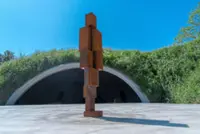'For my latest show, I explored how cracks in the earth, like veins of life, sustain ecosystems by channelling water and air. Yet, relentless industrial pursuits like logging and construction easily disrupt this delicate balance,' says Umi. Photo: The Star/Ong Soon Hin
For artist Umibaizurah Mahir Ismail, better known as Umi, her latest solo exhibition, Rekah, is a homecoming of sorts.
“My last show in Malaysia was in 2016 – a lot has happened since then,” says Umi, 49, in an interview at Sareng Gallery in Kuala Lumpur, where the exhibition is currently on display.





